ArticleThe Image Regime of Particle Physics: Photographic Strategies at CERN
Olga Osadtschy
The Image Regime of Particle Physics: Photographic Strategies at CERN
Photogenic Machines
My first and only encounter with ATLAS, one of the two large particle detectors at CERN’s Large Hadron Collider, was above all an aesthetic experience. Not long before I visited, the huge structure (46 metres in length, 25 meters in diameter and with a weight of 7,000 tonnes) had been officially unveiled as the largest machine in the world and was widely reported on in the media. Pictures of the inside of the detector went around the world (fig. 1). Standing in front of the machine – whose image adorned the front pages of the specialist press – 100 metres below the earth’s surface during the first shutdown, I could not help asking myself: Was the particular beauty of this huge material mosaic a sine qua non or a side effect of the search for the so-called God particle? Could CERN afford to present a less photogenic machine to the public here?
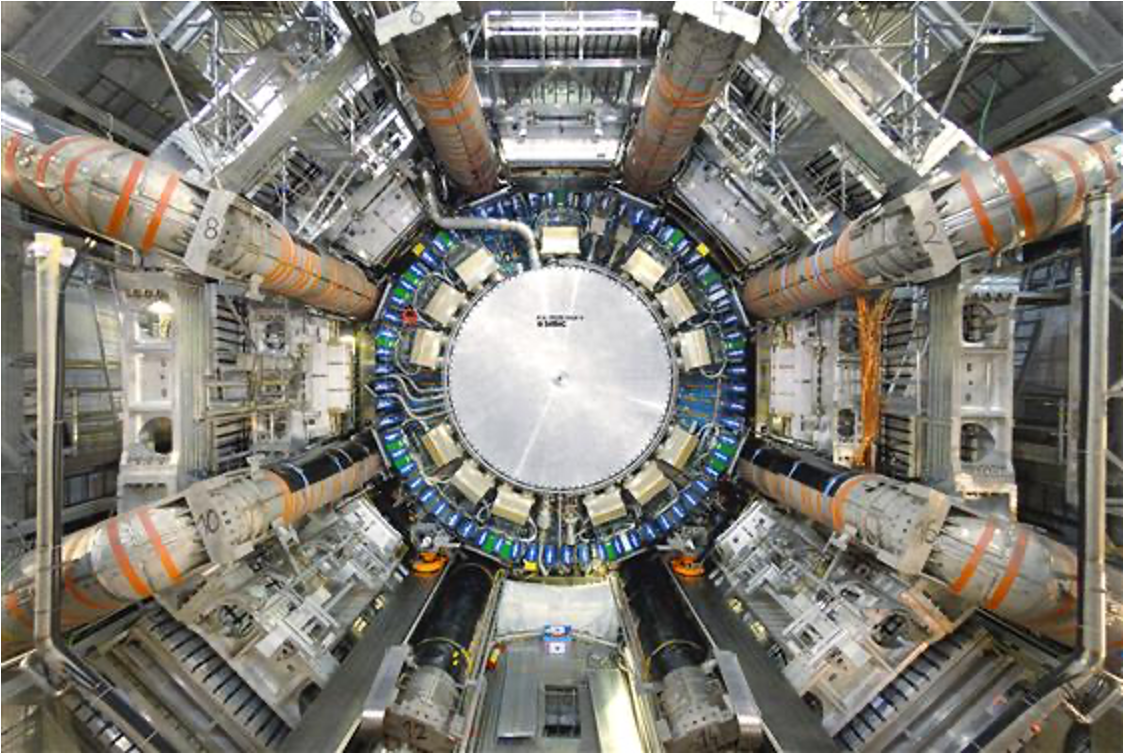
The Conseil Européen pour la Recherche Nucléaire (CERN) was founded in 1954. Since then, there have been financial and symbolic resources at stake, relating to the distribution of public and private monies and international competition for kudos. The image that has emerged of the laboratories and scientists is based to a significant degree on visualisations that betoken success while also conveying eye-opening information, whether they manifest as photographic verification of a ‘golden event’ or a computer-generated graphic.[1] Since 2014 the CERN Photo Lab has digitised hundreds of thousands of images, which it has made available online. A look at the lab’s archives reveals how diverse the visualisations, image carriers and regimes of display have been in terms of how prestigious machines that also generate prestige are presented to the public.
After a few hours on the digital platform, it is evident that since its founding CERN has fostered a sophisticated photographic practice that is both comprehensive and sophisticated, providing a meticulous record of the people, machines and elementary particles involved in its research. Part of the work of organising the research institute thus also involves organising the flows of images, which play an important role in the race for equipment, research outcomes and superlatives, because there can be no knowledge without storage and presentation media.[2]
The price to be paid for digital accessibility is that the image material is evened out such that the nuances and hierarchies in the use of images become difficult to see. It is not apparent at first sight what criteria have been applied first in taking the pictures and then in digitising them. The gaps in the information system indicate, for example, the images that did not appear in publications and lectures or make the headlines but were set aside as obsolete and forgotten materials, left to moulder away, quite literally, in some staff member’s drawer.[3] Importantly, this is also a large-scale ‘citizen science’ project in which visitors to the digital archive can fill in the gaps in the web of information themselves and suggest titles and descriptions.
One of the radical changes that characterised the history of physics in the 20th century was the shift toward conducting experiments on this kind of industrial scale.[4] This process began immediately after the Second World War and led to a steady increase in the size of projects, the number of people involved and the amount of visual material generated. The bubble chamber, a particle detector that, unlike ATLAS, itself produced analogue photographs – in their millions – constituted the first of the large-scale international physics projects that were conducted in the 1950s.
The focus in this essay will be on analysing some of the image strategies deployed for the bubble chamber and examining photos produced by the bubble chambers themselves as well as photos of the bubble chambers, the laboratory and members of staff. Taken together, these operational images, which are linked in with sequences of events, are key to a history of science and images that focuses on practices and material qualities rather than results and discoveries. In addition, these photographs were tokens in a system of exchange involving knowledge, money and material, in which a major consideration was what an experiment should be.[5]
The Lab as Image Factory
Simply put, bubble chambers were large and sometimes dangerous imaging machines that were typically filled with liquid hydrogen heated to a high temperature. Particles that had been charged in the accelerator moved through the tank, leaving visible traces in their wake. The liquid began to boil along its path, forming bubbles in the process. When the bubbles were large enough, cameras took photographs through windows installed in the bubble chamber recording the event from different angles to make it possible for researchers to reconstruct the space by superimposing the images. A magnetic field around the bubble chamber caused the particles to move along bending paths, with each forming typical motion curves. Calculations of the density of the bubbles and the momentum of a particle could provide clues to help identify it.
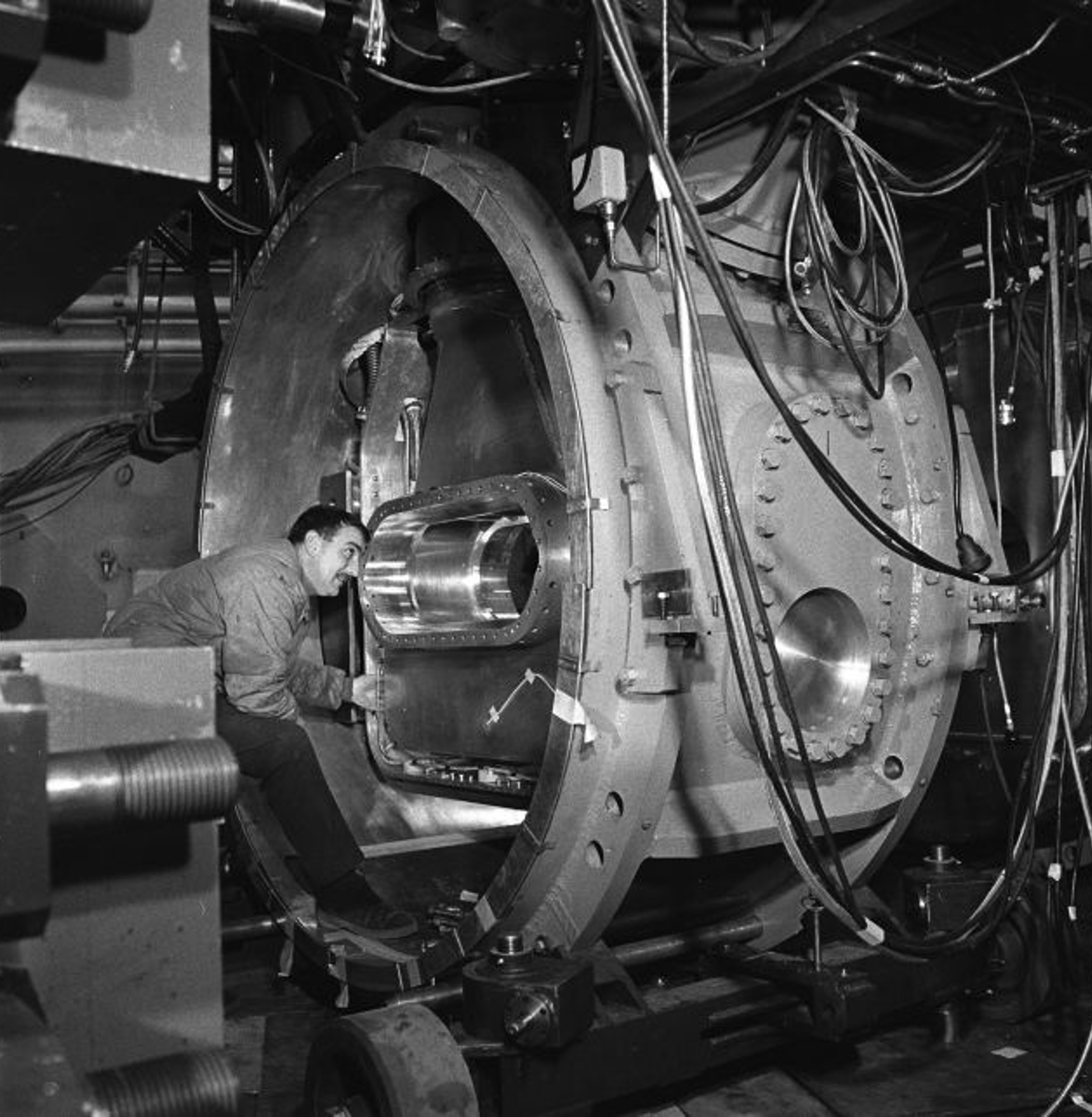
If we compare photographs of the construction and servicing of the 81-centimetre bubble chamber (fig. 2) with images of the Big European Bubble Chamber (fig. 3), we can readily see that the size of the tank (81 cm vs. 3.7 m) had a radical impact on the dimensions and make-up of the surrounding facilities. Wild growth is a special property of physics: ‘Experimental devices in physics often manifest as structures that develop with increasing sophistication from small prototypes into large pieces of machinery before ultimately becoming enormous installations with their own maintenance and management requirements.’[6] Hundreds of people were involved in an experiment, necessitating the strict organisation of different teams. All in all, the bubble chamber experimental system cost millions and was bound up in complex networks relying on the transfer of materials and technical expertise, which went beyond the limits of particle physics and laboratory work.[7]
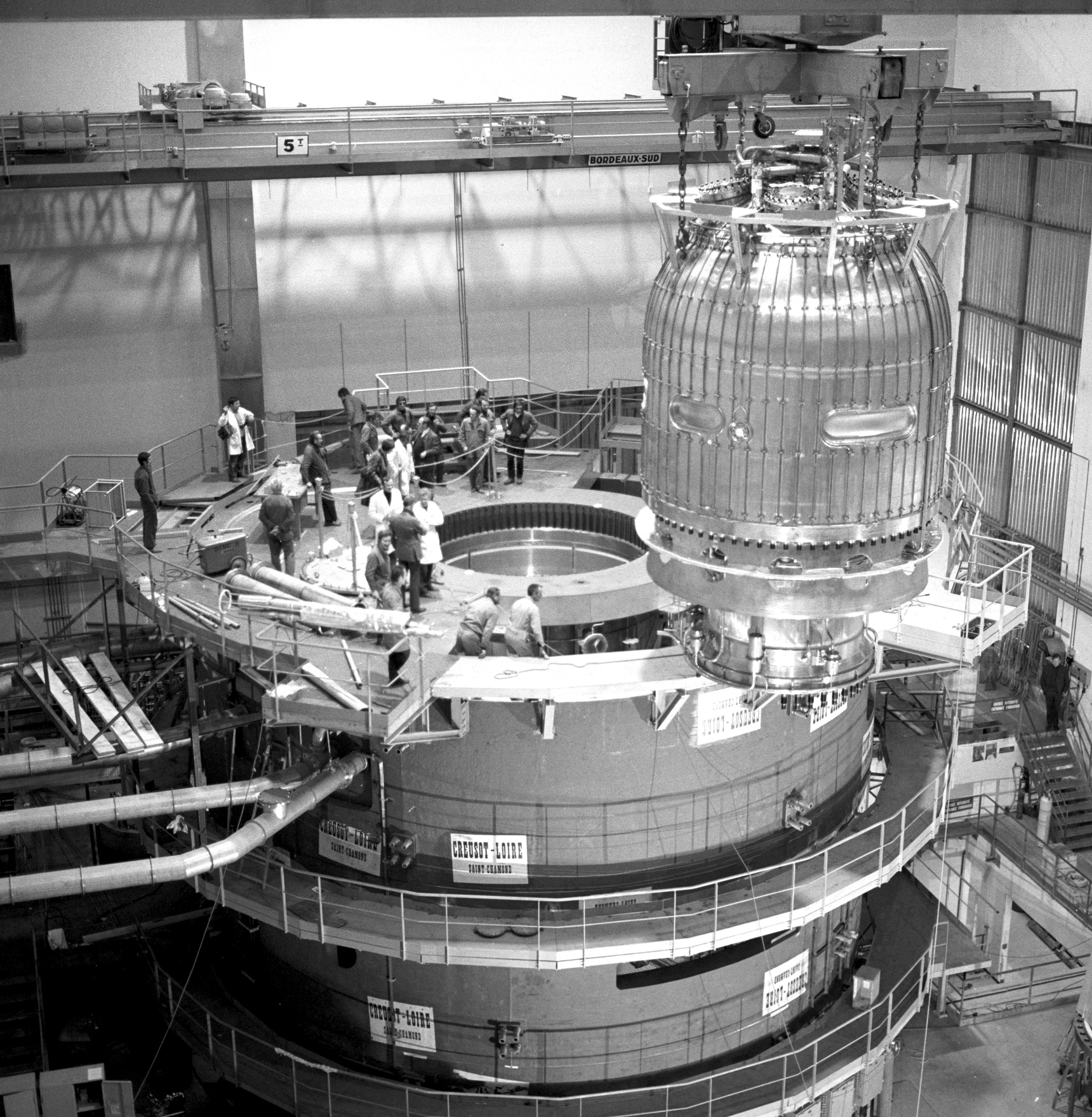
In the search for new particles, the bubble chamber gradually replaced both the cloud chamber and work done with photographic emulsions and cosmic rays, which had been the standard in particle physics for years.[8] In the post-war period, the relatively autonomous particle physicists working flexibly in remote mountain stations were replaced by ‘identity cards, safety protocols, shift work and factory style organisation’.[9] The physicist became one of many people observing from a distance, if only for safety reasons.
The improved performance of the chambers led to a surge in the use of film material. A series of photographs were taken in 1967 that emphasise the materiality of this process. In one picture, a man checks a curtain composed of drying film strips (fig. 4). His outline, in particular his white lab coat, glows brightly behind the transparent material. The strong contrast of light and dark and the pronounced low-angle viewpoint help create an aesthetic that verges on the avant-garde. What is particularly interesting here is to see a variety of aesthetic decisions and visual strategies intersect: the film material – the image carrier itself – becomes the main player. We see a man looking at freshly developed film material, which is the product of the mechanical objectivity of a finely calibrated machine that is automated to record processes precisely – without human intervention. The phenomena are to be registered of their own accord, first in the liquid of the bubble chamber tank and then on the film material. The picture we are looking at, meanwhile, has been taken by a photographer who has obviously been trained in his art and uses all its rules to create a scene that has as much atmosphere as possible. The caption on the homepage reveals that the two bubble chambers at CERN took 2,161,000 pictures in 1966, a little more than half of which were analysed in European universities. It is difficult to imagine this kind of quantity, but the curtain of film material makes the point by reducing it to a level that is visually comprehensible.
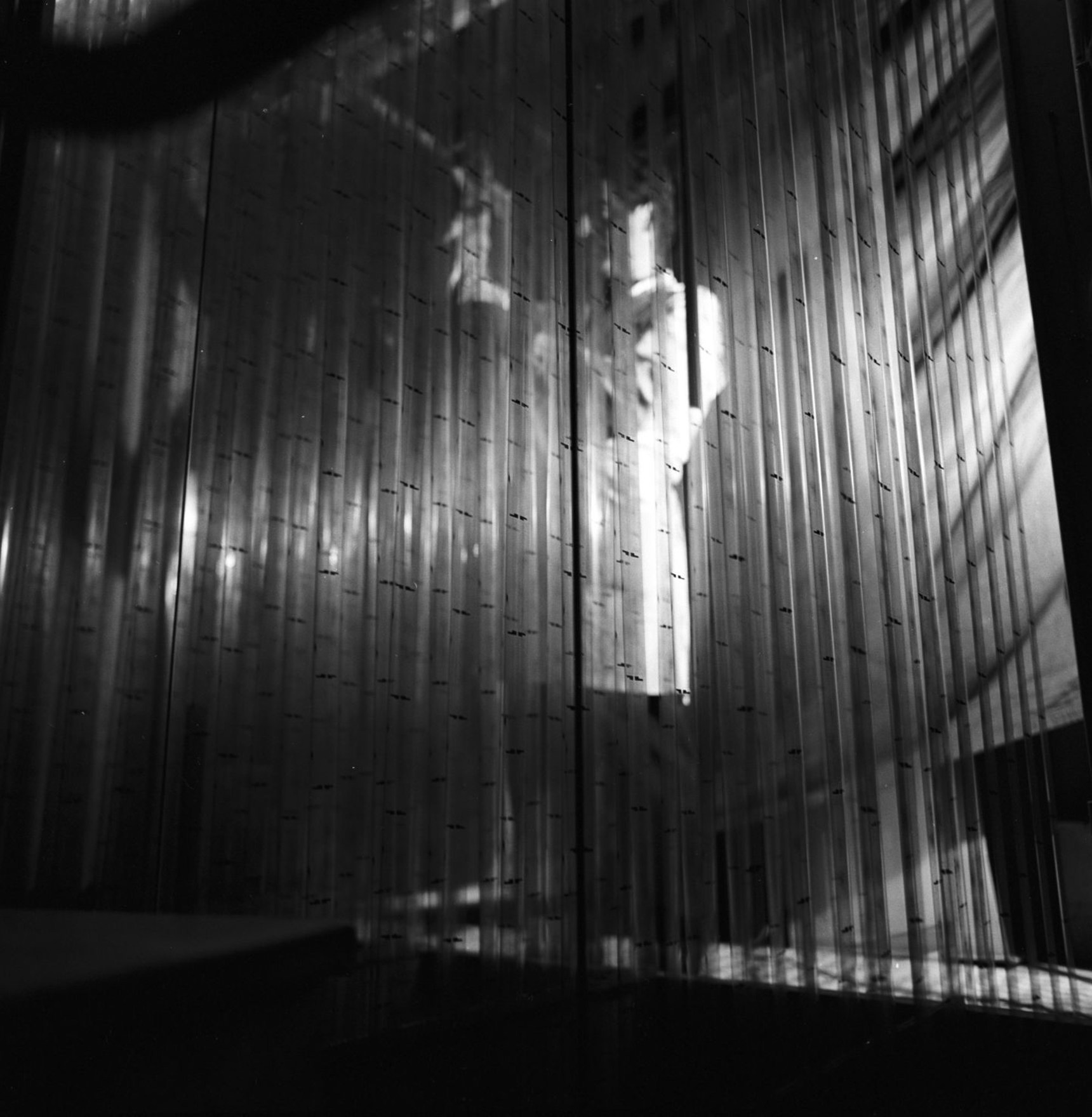
Scientific Images and Images of Science
A research institute’s success was determined by the number of photographs produced each year and the speed and efficiency with which they could be analysed.[10] Visual records of various kinds were created too: photographs from the bubble chambers were scanned, measured, digitised and converted into 3D models or diagrams. The different work steps, machines and infrastructures were photographed extensively and found their way into various publications, including the organisation’s annual reports and its internal monthly magazine, CERN Courier. Some found their way into the public domain, while others only made it as far as the dustbin. There was, moreover, a constant visual connection to the bubble chamber: it had a built-in control screen, which despite supplying poor-quality images was at least able to maintain the illusion of direct involvement in events. For ‘in any nuclear “experiment”, the crucial moment is when the animal is actually being killed, I mean when the nucleus or the photon or whatnot is actually striking the detector.’[11] Yet the real trophy was, of course, the photograph itself, very much in line with Oliver Wendell Holmes’s ironic prophecy that in the future there will be libraries of stereoscopic images and that ‘men will hunt all curious, beautiful, grand objects, as they hunt the cattle in South America, for their skins, and leave the carcasses as of little worth.’[12]
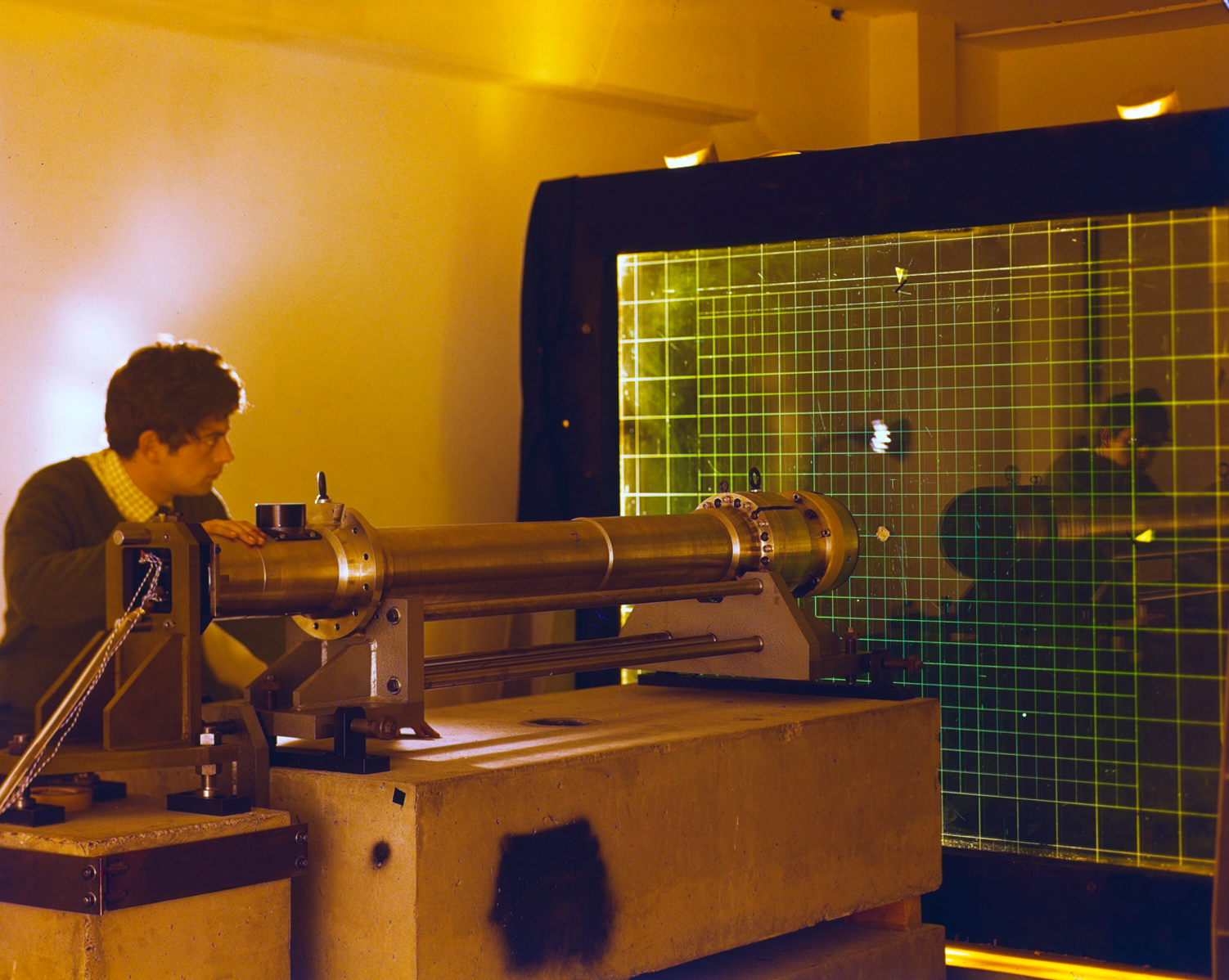
As the challenges grew bigger, so did the mechanical eye of the bubble chamber. With the search for the smallest building blocks of the world requiring ever larger equipment, size became a source of error. Optical distortions of several centimetres were not uncommon. Given the size of the elementary particles, such falsifications were disastrous, so the lenses needed to be calibrated – a complex and costly process (fig. 5). Away from the bubble chambers themselves, a wide range of Instruments for the Evaluation of Photographs (IEP) were developed to deal with the increasing amount of film material (and the changing formats). Behind scanning tables with names like Milady, Bessy, SAAB and ERASME, technical assistants, so-called scanning girls, searched the film material for interesting events (fig. 6), digitised what they found and prepared punch cards for the computer-assisted measuring process – which will not be examined in detail here.[13]
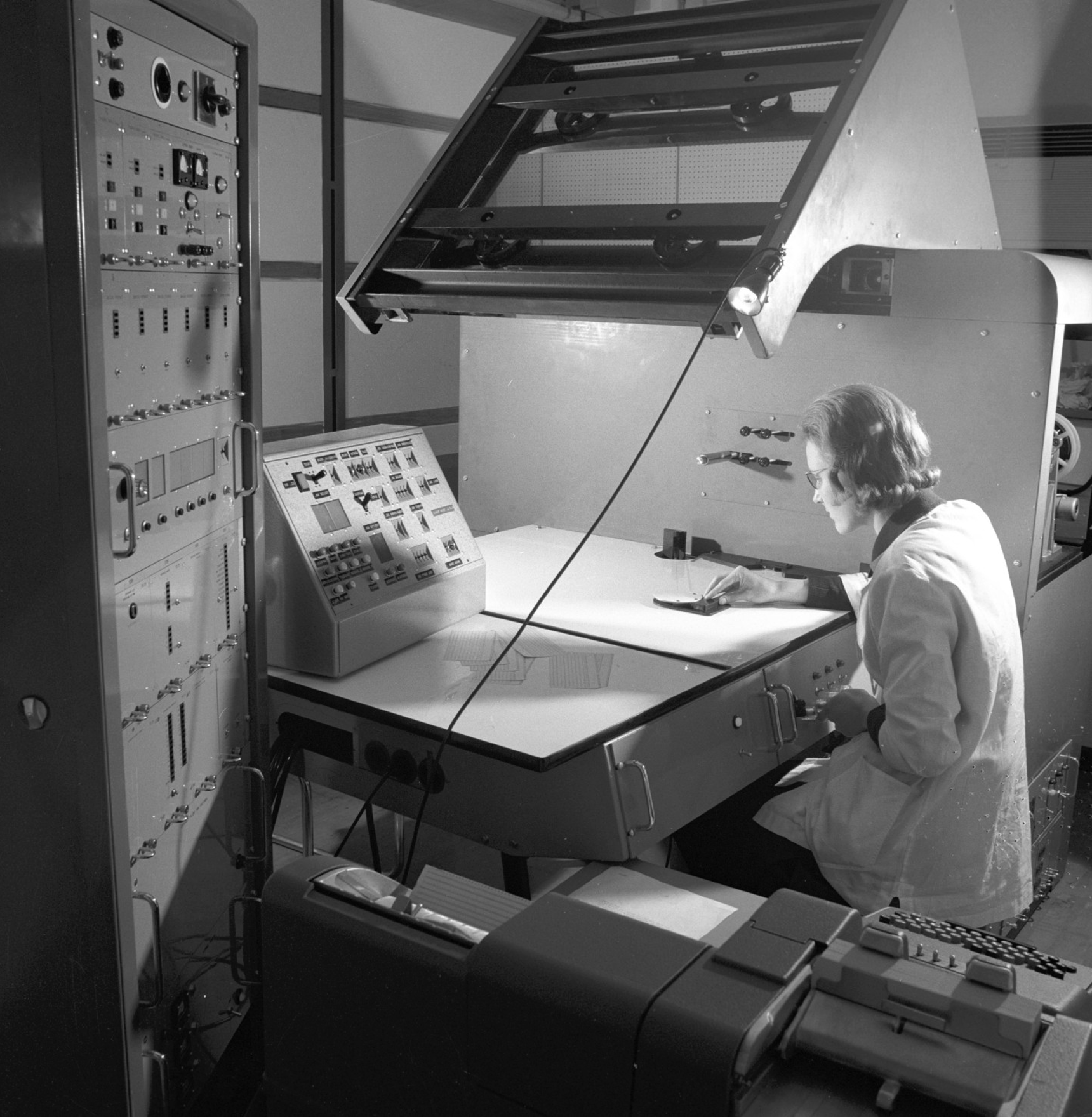
The bubble chamber photographs enjoy an iconic status among the host of images that CERN has published since its establishment in 1954. The characteristic images of delicate curving lines, spirals, waves and bubbles superimposed on one another grace hundreds of books and magazines. In his book Image and Logic, Peter Galison attests to the ‘decorative dominance’ of these photographs in the field of high-energy physics (fig. 7).[14] What is the source of this success, which extends far beyond specialist circles? As ‘inscriptions’, the photographs, in the first instance, refer to concrete events in the laboratory, while at the same time being ‘fragments’ of an experimental system, with every circle, every point and every curve charged with latent significance. As ‘immutable mobiles’, the photographs combine a whole range of favourable properties, being ‘mobile, flat, reproducible, still and of varying scales’, and can thus effortlessly become elements in different contexts, publications and systems.[15] The processes of media transformation led to a new mode of experimentation in the form of collective and decentralised image work carried out on a global scale, because, given sufficient computing power, film material could be regularly re-evaluated anywhere in the world.
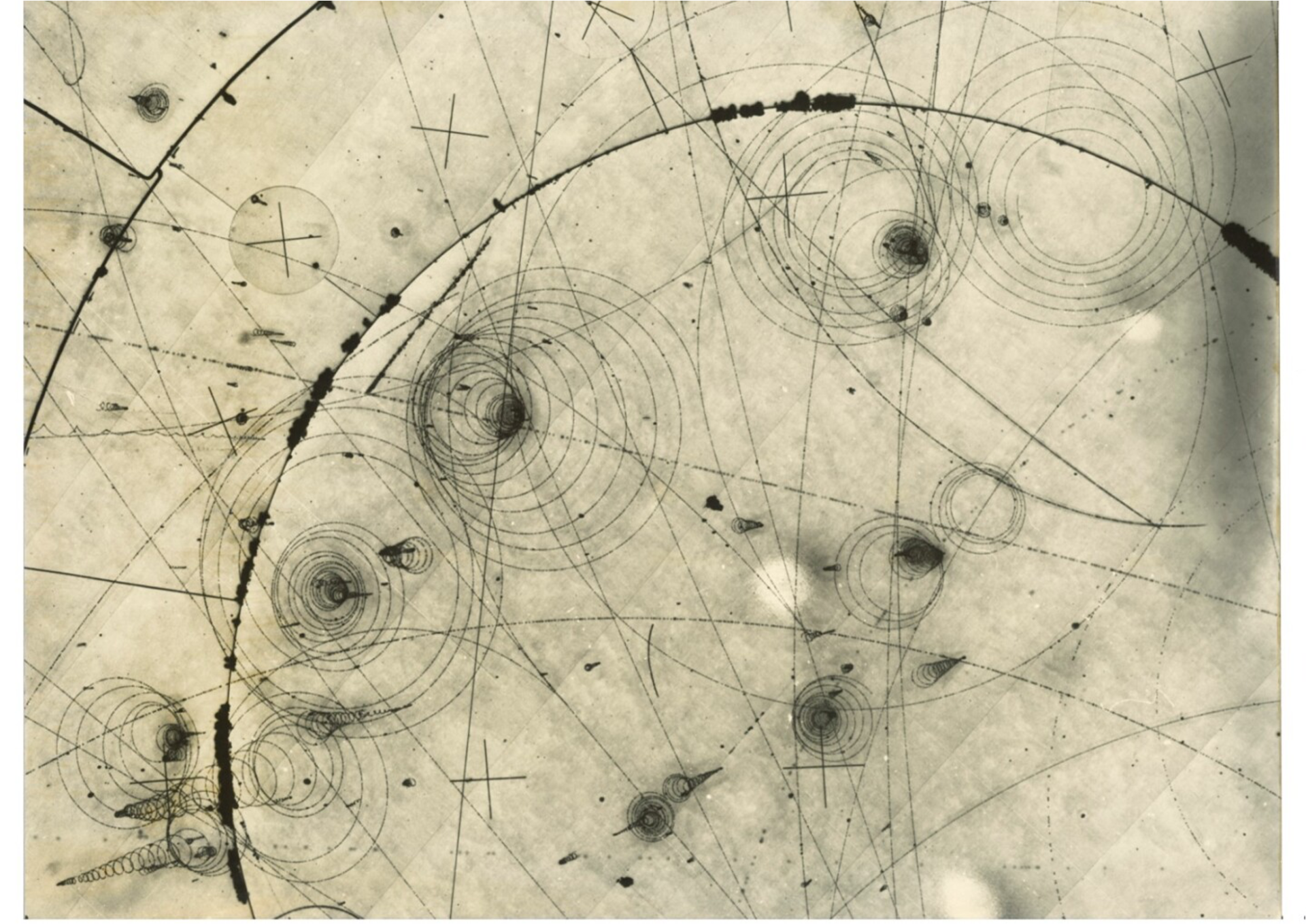
There are other factors that make these photographs successful: for the layperson, they are beautiful inasmuch as they are cryptic. The traces of particles arrested in their motion, the intimate architecture of the inside of the bubble chamber and the guide lines and crosses that are supposed to make it easier to control the image data combine to produce a complex visual whole. My unpractised eye, which is illiterate when it comes to physics, does not see the movements of transient mesons but rather Paul Klee’s delicate, playful lines and suggestions of the finely chased entities that populate Wassily Kandinsky’s late work. The effet du réel of the building blocks that make up the world, which are otherwise invisible to us, has an aesthetic value that is independent of any utility value it might have as the basis of a scientific argument. A recent example here is the Bubble Chamber Sand Mandala, in which artists Chris Klapper and Patrick Gallagher used a photo from a bubble chamber at the US laboratory Fermilab to create an enormous mandala of blue sand, only to sweep it up again as part of a performance after working on it for thirty days.[16]
But how is this photograph to organise physical knowledge? In attempt to get a theoretical and discursive grip on the scientific image, Inge Hinterwaldner and Markus Buschhaus have put forward the concept of the ‘composite’, ‘whose functionality derives from its manifold relationality.… Accordingly, every concretely realised scientific image is made up of myriad factors that include, for example, image practices, visualisation techniques, measurement methods,… conventions within the discipline, reclassifications.’[17] The idea of an experiment that extends far beyond the confines of the laboratory is congruent with the definition of an image that includes the conditions of its realisation as well as its continued existence as the basis for argumentation (of a scientific or artistic nature or relating to scientific policy).
Tricky Girlware?[18]
The idea of the composite allows us to follow up by asking how the natural sciences are organised to provide meaningful images? In the case of the bubble chamber photographs, the answer was this: by radically dividing responsibilities between the sexes. Nuclear physics continued to be a male-dominated area for a long time. This applied to the work on the bubble chamber and on the cameras and extended to the design and construction of the IEPs (fig. 8).

The ‘scanning’ work – the quick checking and analysis of the images – was carried out by women, as had been the case with the cloud chambers. It had become established practice to recruit women for data processing as a means to help manage the huge volume of images quickly and efficiently.[19] As affirmed by a clip from a 1970 documentary film made in 1970, ‘nothing can quite replace the eyes of the scanning girl in a hunt for the tracks of the whimsical neutrino.’[20] Not least because experience and intuition could be used to identify problematic patterns that both computers and physicists were unable to detect. CERN’s photo archive is correspondingly rich in images of different IEP models, with the ‘scanning girl’ and the machine constituting a practised, increasingly complex – and photogenic – unit (fig. 9). This photo should be seen as nothing less than a composite. It concentrates knowledge about the way the laboratory-as-factory functioned. It shifts attention away from the result to a sub-process and augments the actual photographs of particle movements taken in the bubble chamber, enriching them with other layers of meaning – such as the insight that in around 1950 big visual data enabled thousands of women to have access to the physics laboratory. On top of that, the ‘scanning girl’, who was photographed many times between the 1960s and the 1970s, seems like a glimpse into the future of experimental physics. Galison describes it as a long path to a momentous insight: ‘That someone could count himself (or, more rarely, herself) as an experimenter while remaining in front of a computer screen a thousand miles from the instrument itself.’[21]
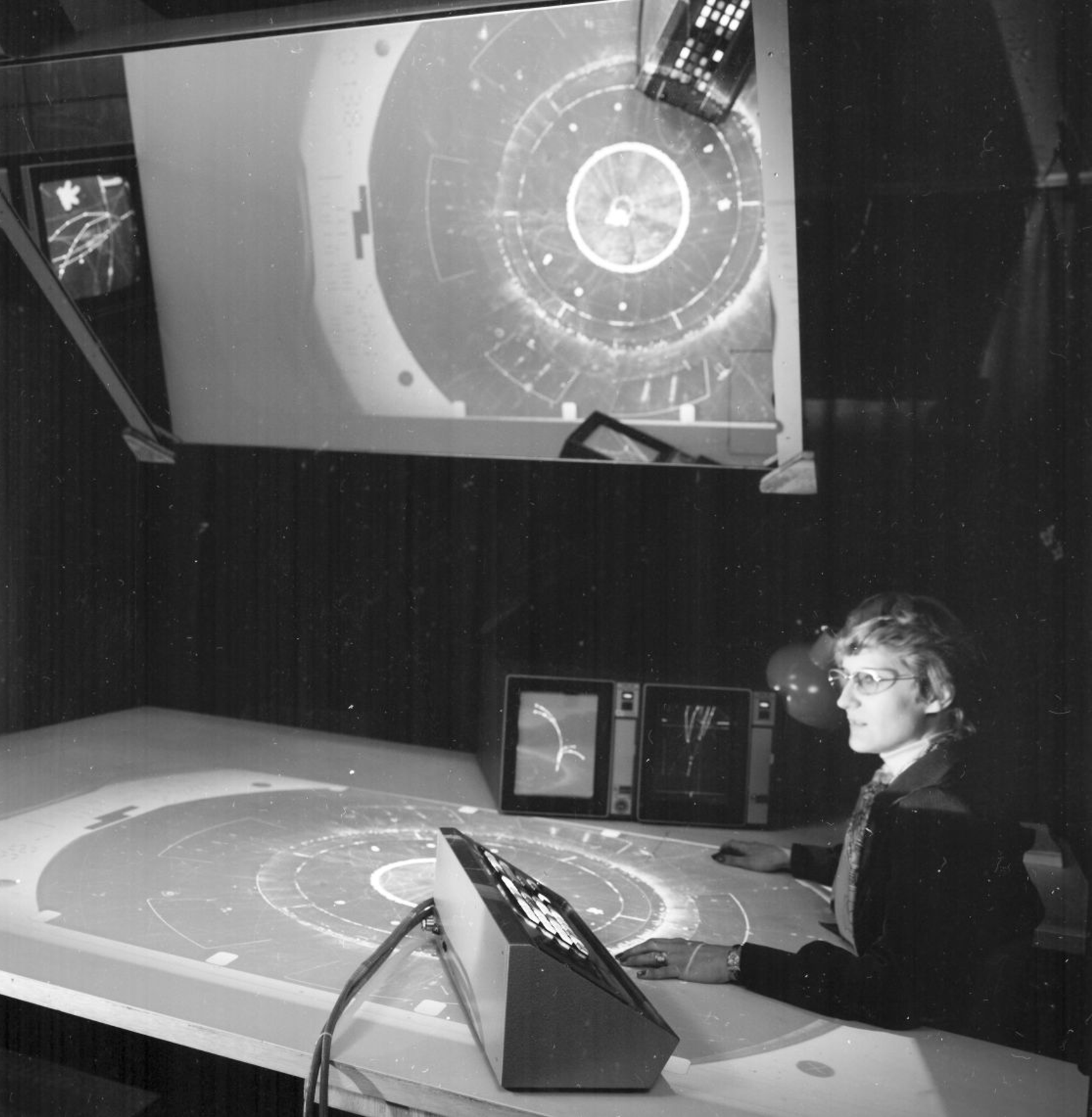
One of the few exceptions to the absolute dominance of women at the scanning tables can be found on the cover of the January 1965 issue of CERN Courier (fig. 10): a black-and-white photo showing the profile of a man at work. It is only possible to draw inferences from this once you have dipped inside the magazine: ‘The cover photograph, a study of concentration, shows one of the visiting scientists from the U.S.A. at CERN, Robert Tripp, inspecting the tracks of sub-nuclear particles as recorded by the cameras of a bubble chamber.… A digitizing system for measuring the tracks can also be added, so that the table can be used in conjunction with a flying-spot digitizer for semi-automatic analysis of the data (HPD system).’[22] While the text extols digital progress, the physicist, who is armed with paper and pencil, is still very much in the analogue world and even takes on the job of a ‘scanning girl’ for the photo session by studying the projection on the table in a plausible way.

During these years, the requirements for young experimental physicists were in a process of radical change. A 1972 report by the National Academy of Sciences summarises the complex social profile as follows: in addition to having a sound knowledge of theoretical physics, electronics, computer science, accounting and psychology, he is ‘disciplined, as required for a large-scale group effort, in all the troublesome aspects of technical teamwork.’[23] Does Tripp come up to expectations as an all-round talent in the areas of administration and science? Perhaps. In any case, he seems to have mastered the business of interacting with the ‘tricky girlware’.[24] If you research this series of photos in the CERN picture archive, you will also find Tripp talking to a ‘scanning girl’, although she remains in the background (and her name is not mentioned, fig. 11). If, as Galison writes, the physicists were obliged to surrender the moment of discovery – the first glimpse of a new phenomenon – to the teams of women scanners, is this photo then an exercise in image politics, an attempt to reappropriate the moment of discovery?[25] In this picture at least, the physicist has to some extent recovered control over the experiment – something that had become increasingly elusive: the nameless ‘scanning girl’ disappears into the image archive and Tripp is left alone with the bright projection surface on the state-of-the-art scanning table, at least for the purposes of the cover photo. In retrospect, this might be one of the last attempts to rescue the traditional image of the physicist in intimate contact with his experiment and freed from the entanglements of the modern laboratory – at least for the time it took to snap the shot.
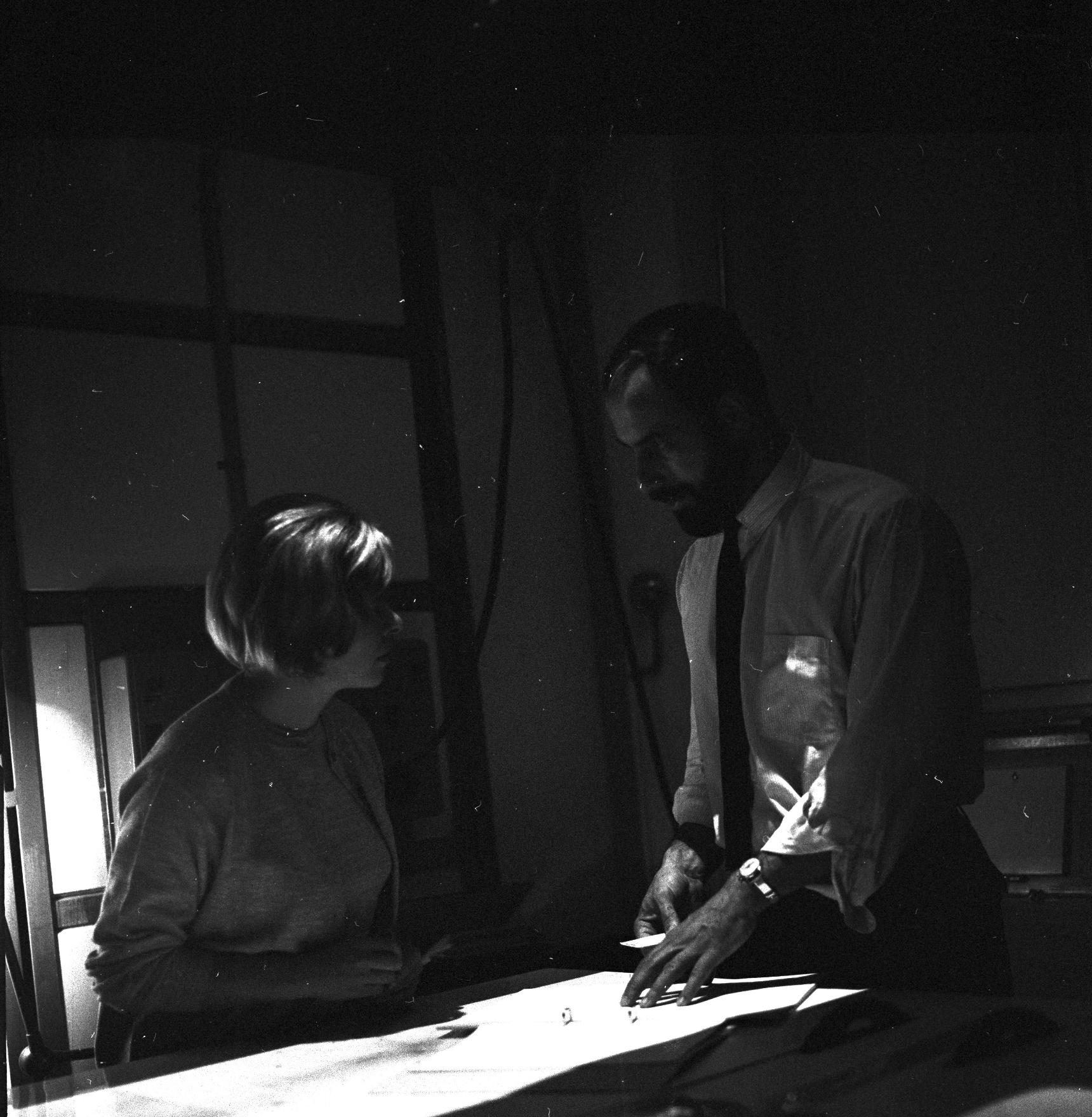
[1] Peter Galison: Image and Logic: A Material Culture of Microphysics, Chicago and London: University of Chicago Press (1997), p. 22. In his encyclopaedic book on the apparatus of physics and the issue of visual imagery in research, Galison gives the following description of the ultimate visual proof: ‘The golden event was the exemplar of the image tradition: an individual instance so complete, so well defined, so “manifestly” free of distortion and background that no further data had to be invoked.’
[2] See Philipp Sarasin: ‘Was ist Wissensgeschichte’, in: Internationales Archiv für Sozialgeschichte der deutschen Literatur (IASL) 31/1 (2011), pp. 159–172, p. 168.
[3] The exhibition Breaking the Mould (November 2019 at CERN) showed negatives that had been found in a drawer as part of the Digital Memory Project. Once the mould had been cleaned from the negatives, they were found to be beautiful in artistic terms. The biochemical destruction of the visual information had created objects that were mysterious, abstract and full of intense colour. See https://www.swissinfo.ch/eng/multimedia/mould-masters–_rotting-cern-photos-turned-into-art/44555544 (19 November 2018).
[4] The operational industrialisation of physics laboratories is also contingent upon the transfer of knowledge from key wartime research institutes. The large, publicly funded wartime research projects had also led to a greater willingness to provide substantial financial support for laboratories from the public purse.
[5] Peter Galison: Image and Logic: A Material Culture of Microphysics, Chicago and London: University of Chicago Press (1997), p. 6.
[6] Hans-Jörg Rheinberger: Experimentalsysteme und epistemische Dinge, Göttingen: Wallstein-Verlag (2002), p. 33.
[7] See also Peter Galison: Image and Logic: A Material Culture of Microphysics, Chicago and London: University of Chicago Press (1997), p. 51. To give an example, the knowledge of which coatings should be selected for bubble chambers to achieve better picture quality was derived from the entertainment industry. Faced with the problem that a particularly large bubble chamber could not be recorded using the typical methods of darkroom exposure – as was the case with microphotography – researchers opted for Scotchlite reflective film, a product that the 3M company had been selling to the film industry since 1940.
[8] See Clinton Charloner: ‘The Most Wonderful Experiment in the World: A History of the Cloud Chamber’, in: The British Journal for the History of Science 30/3 (September 1997), pp. 357–374.
[9] See Peter Galison: Image and Logic: A Material Culture of Microphysics, Chicago and London: University of Chicago Press (1997). In this comprehensive publication, the science historian reconstructs in minute detail the way lab practice and thinking changed. He distinguishes between the inner and outer laboratory, between the physicist’s direct working environment and the institution in which this inner laboratory is embedded (p. 4). Although both levels are subject to change, the physicist’s immediate environment is noticeably affected for the first time by the bubble chamber (p. 35).
[10] Peter Galison: Image and Logic: A Material Culture of Microphysics, Chicago and London: University of Chicago Press (1997), p. 387. ‘Nothing mattered more than a crucial ratio: the rate of picture production from the bubble chamber (per year) divided by the rate of measurement of these pictures (per year).’
[11] Lew Kowarski: ‘Impact of Computers on Nuclear Science’, in: International Centre for Theoretical Physics (ed.): Computing as a Language of Physics: Lectures Presented at an International Seminar Course, Trieste, 2–20 August 1971, Vienna: International Atomic Agency (1972), pp. 27–37, p. 30.
[12] Oliver Wendell Holmes: ‘The Stereoscope and the Stereograph’, in: Atlantic Monthly (June 1859), pp. 738–748, p. 748, https://cdn.theatlantic.com/media/archives/1859/06/3-20/131866379.pdf.
[13] Various names have been used here: although the term ‘scanning girl’ was used in the sixties and seventies, this expression has since become obsolete. CERN’s homepage and other publications now talk about ‘scanners’ or ‘operators’.
[14] Peter Galison: Image and Logic: A Material Culture of Microphysics, Chicago and London: University of Chicago Press (1997), p. 38.
[15] Bruno Latour: ‘Visualization and Cognition: Thinking with Eyes and Hands’, in: Henrika Kuklick (ed.):Knowledge and Society: Studies in the Sociology of Culture Past and Present, vol. 6, Greenwich, CT: JAI (1986), pp. 1–40, p. 21.
[16] An article on the project and photographic documentation of it can be found here: https://www.symmetrymagazine.org/article/the-bubble-chamber-sand-mandala (22 February 2019)
[17] Inge Hinterwaldner and Markus Buschhaus: ‘Zwischen Picture und Image: Überlegungen zu einem komplementären Kompositbegriff’, in: Inge Hinterwaldner and Markus Buschhaus (eds.): The Picture’s Image: Wissenschaftliche Visualisierung als Komposit, Munich: Wilhelm Fink Verlag (2006), pp. 9–20, pp. 18–19.
[18] After Kowarski moved away from the idea of the human operator being completely superseded by the computer, he summed up the situation with a quirky remark that most likely points to more deep-seated conflicts in the relationship between the sexes at CERN. “Should we add to tricky hardware and tricky software also tricky girlware?’ Lew Kowarski: ‘Concluding Remarks’, in Brian Powell and P. Seyboth (eds.): Programming for Flying Spot Devices: A Conference Held at the Max-Planck-Institut fur Physik and Astrophysik, Munich, 18–20 January 1967, pp. 409–416, p. 414, quoted in Peter Galison: Image and Logic: A Material Culture of Microphysics, Chicago and London: University of Chicago Press (1997), p. 409.
[19] On a history of women as computers during the Second World War, see also Jennifer S. Light: ‘When Computers Were Women’, in: Technology and Culture 40/3 (July 1999), pp. 455–483.
[20] Gargamelle, CERN, 1 January 1970, 02:55–03:01, https://videos.cern.ch/record/1069969. This video is a collage of various unspecified historical documentaries.
[21] Peter Galison: Image and Logic: A Material Culture of Microphysics, Chicago and London: University of Chicago Press (1997), p. 5.
[22] CERN Courier 5/1 (January 1965), p. 2.
[23] National Academy of Sciences: Physics in Perspective, Washington, DC: National Academy of Sciences (1972), vol. 2, p. 114. Quoted in Peter Galison: Image and Logic: A Material Culture of Microphysics, Chicago and London: University of Chicago Press (1997), p. 9.
[24] Inge Hinterwaldner and Markus Buschhaus: ‘Zwischen Picture und Image: Überlegungen zu einem komplementären Kompositbegriff’, in: Inge Hinterwaldner and Markus Buschhaus (eds.): The Picture’s Image: Wissenschaftliche Visualisierung als Komposit, Munich: Wilhelm Fink Verlag (2006), pp. 9–20, pp. 18–19.
[25] Peter Galison: Image and Logic: A Material Culture of Microphysics, Chicago and London: University of Chicago Press (1997), p. 34.